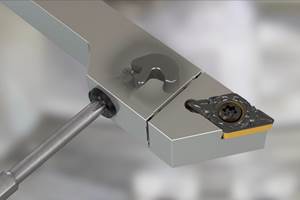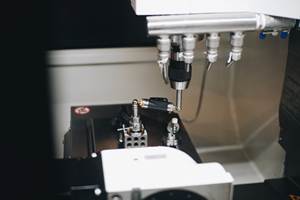Laser Offers High Production For Low Volumes
"Laser technology," says Mr. Brownhill, "is the bridge across the 50 to 500 piece lot size gap. Shops can make money on these volumes, using a laser". And, it's toward this segment of the sheet metal fabrication market that Amada has pointed its high speed Pulsar laser machine.
Share






The world of sheet metal fabrication is ruled predominately by two processes--stamping and punching. Boundaries between these two methods are driven by lot size. According to Mark Brownhill, Development Manager for Amada (U.S.) Ltd. (Buena Park, CA), volume breaks for these processes are: 2,000 pieces and above go to stamping and generally 500 to 2,000 piece lots are processed on turret punch presses.
What about volumes below 500 pieces? Many fab shops have ignored or at least avoided the 50 to 500 lot size market, because generally, conventional metal fabricating simply isn't cost effective at these volumes.
However, more available work is falling into this lot size no-mans-land. For example, the 2,000 piece break point, common today, used to be 5,000. Many shops are looking at how to make money on volume sizes they would probably not even quote on five years ago.
"Laser technology," says Mr. Brownhill, "is the bridge across the 50 to 500 piece lot size gap. Shops can make money on these volumes, using a laser". And, it's toward this segment of the sheet metal fabrication market that Amada has pointed its high speed Pulsar laser machine.
Prototyping has been the traditional niche for laser sheet metal processing. Shops making one or a few pieces use lasers because there is no tooling cost associated. Setup is also minimal. Historically though, once a prototype design is proved on a laser, tools are ordered and production then goes to a turret punch or (for high volume) a stamping press because of their processing speed.
This new machine, introduced last fall, is designed to break out of prototype work and move laser cutting into the production machine arena--competing with turret punch presses. But to compete on a production basis the laser had to at least have parity with the processing speed of a turret punch press.
Looking at the whole picture of laser cutting, Amada developed a new machine design. It combines many small enhancements such as a high speed piercing technique, improved material handling and a faster CNC processor to deliver a laser cutting system for high-production of short-runs.
Together these small refinements add up to processing speeds comparable to turret punch presses. Using the high speed piercing technique for example, an impressive 140 holes per minute cut speed can be achieved in cold rolled steel.
A second technique, called dynamic piercing, uses CNC to control the laser shutter. When the beam enters a cut, the CNC adjusts the shutter to allow the right amount of power for piercing and cutting so maximum laser efficiency and speed are realized. In tests on 3/8-inch diameter holes on 1-inch centers, a rate of 100 holes per minute was achieved--over 66 percent better than a conventional laser cutting machine.The newest model in the Pulsar series is the 2415 XL. It compliments the model 1212 introduced at IMTS 94. The 2415 XL is a bigger frame size than the 1212 and accommodates a 5' x 16' sheet versus a 4' x 8' sheet on the 1212.
Power options for the 2415 XL include 1500, 2000 and 3000W lasers to cut a variety of material specifications. Laser beam delivery on Pulsar uses a single moving optic for simpler beam alignment. An additional CNC servo-axis is allocated for control of laser focus. It gives precise positioning accuracy for faster setup. This CNC servo control takes guesswork out of focusing the beam.
Motion system design for Pulsar uses X-axis to move material on the machine bed. Y-axis moves the laser across a fixed bridge. This intersecting axis design reduces the amount of floor space to 18.4' x 9.3' for the 2415 XL model.
Three sheet metal holding clamps retract automatically when the cutting head approaches. This helps eliminate clearance "dead zones" around the clamps. A dual-axis gage block system simplifies sheet alignment. Pulsar can operate as a stand-alone machine or it's capable of integration with any of Amada's material handling systems.
A Fanuc 16L 32-bit CNC provides control for the laser machine. It handles X-,Y- and Z-axis linear motion control of the automatic focus servo and interface with automation and materials handling devices. The CNC is designed specifically for laser applications. A graphic interface makes acquisition of operating parameters from a resident cutting-data library easy for operators. As industry's trend to lower break-even piece volumes continues, more metal fabricating shops are looking for ways to make money on smaller lot sizes. Lasers may be worth considering as a way to profitably process sheet metal in the 50-500 lot size range.
Related Content
Quick-Change Tool Heads Reduce Setup on Swiss-Type Turning Centers
This new quick-change tooling system enables shops to get more production from their Swiss turning centers through reduced tool setup time and matches the performance of a solid tool.
Read MoreBallbar Testing Benefits Low-Volume Manufacturing
Thanks to ballbar testing with a Renishaw QC20-W, the Autodesk Technology Centers now have more confidence in their machine tools.
Read MoreOrthopedic Event Discusses Manufacturing Strategies
At the seminar, representatives from multiple companies discussed strategies for making orthopedic devices accurately and efficiently.
Read More6 Machine Shop Essentials to Stay Competitive
If you want to streamline production and be competitive in the industry, you will need far more than a standard three-axis CNC mill or two-axis CNC lathe and a few measuring tools.
Read MoreRead Next
Machine Shop MBA
Making Chips and Modern Machine Shop are teaming up for a new podcast series called Machine Shop MBA—designed to help manufacturers measure their success against the industry’s best. Through the lens of the Top Shops benchmarking program, the series explores the KPIs that set high-performing shops apart, from machine utilization and first-pass yield to employee engagement and revenue per employee.
Read MoreAMRs Are Moving Into Manufacturing: 4 Considerations for Implementation
AMRs can provide a flexible, easy-to-use automation platform so long as manufacturers choose a suitable task and prepare their facilities.
Read More



















